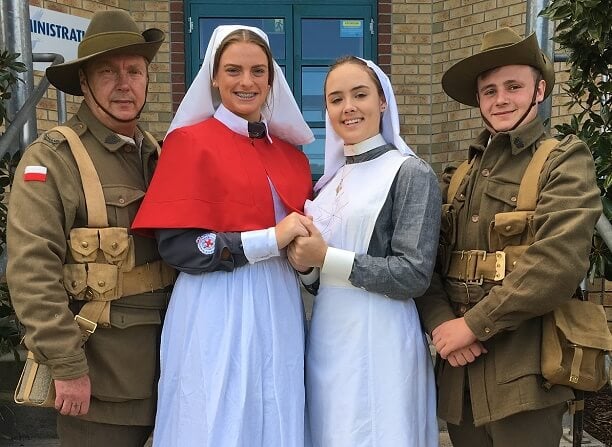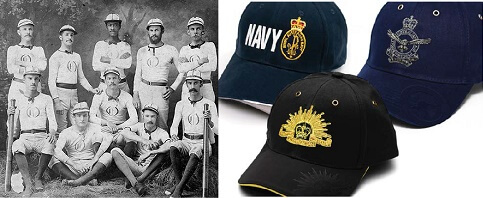
NOT JUST DRESSING UP
Picture: Mark White (left) with Dromana College students Abbey Hutchinson, Brianna McPhan and Ben Camm.
Some Great War reenactors have served. Some are still serving. And many have never worn a uniform other than the replica they wear when they get together. So why do they do it? It’s not cheap. Uniforms can cost many hundreds of dollars and then the extras; rifles, packs and other bits and pieces, can quadruple the outlay. Mark White is a dedicated reenactor who is sharing his passion with young people and getting them involved in remembering our past.
“The most common question I get asked about being a reenactor is “why do you do it?” I suppose you could ask any reenactor and each time you would probably get a different answer. Some may do it in memory of a family member who served in war; others may do it as they have an interest in our military history. But all have a desire to educate the public and show them a glimpse of our past. I do it for a love of history, and I work in a school so I feel it is my job to make sure the youth of today never forget the sacrifices our diggers made, for us, their families, and our country.
Living Historians recreating the past through re-enactment is probably a better way to describe us, and we come from all walks of life. Doctors, mechanics, spray painters, businessmen, even current serving ADF members – we all give of our time to share just a little of the past with the public of today so they may have a greater understanding of our world history.
You will find Living historians recreating life in all its facets, from medieval periods to today’s conflicts, and not all being just soldiers. There are nurses, civilian life, partisans, convicts, aircraft pioneers, and the list could go on and on.
Other questions I am commonly asked is “Is it expensive to get started” and “where do you get all this stuff?” Expense will depend on the impression you wish to portray. My First World War A.I.F. kit was a little over a thousand dollars without the rifle, yet to portray a Second World War soldier can be as little as a few hundred dollars depending on how complete you wish to do the impression. Things are built up over time so the expense is usually drawn out. Shops are available which cater solely for the reenactor, and I have found people will quite readily give you things that have laid in suitcases or sheds for years for which they have no real use for.
So on the 13th of July 2016, I and a group of First World War living historians travelled from all parts of Australia to commemorate the 100th Centenary of the battles of Fromelles and Pozieres in France under the banner of “The A.I.F. Abroad”. Dressed in our A.I.F. kit we toured the battlefields of the Western Front with Chris Barker and Gonzague Carpe as our guides. From marching the original route our Aussie boys took to fight the battle of Polygon Wood 100 hundred years ago, to sleeping and Standing-To overnight in the Christmas trench, we explored the countries and memorials of Belgium and France.
The remains of the horror of war are still very evident, from the remains of German trenches in the backyard of the houses where we stayed, to walking the forests finding gun emplacements, 18pdr shells, decaying trenches and bunkers. We attended both services at Fromelles and Pozieres and were invited back to Polygon wood for the burial of an unknown Australian soldier. It was nice to see the ties between the French and Belgium people are still strong with Australia, and that we were made so welcome wherever we went. When commenting to a Frenchman about how many relics of war remain I think he summed it up by saying “if you could take everything from underground and put it on the surface, everyone would run away”.
In 1916 the Victorian Education Department issued a remembrance coin to every Victorian student, so working at Dromana College I approached my Principal and said “why don’t we do the same thing 100 years later”. So it was decided to have 1450 Australia in the Great War Centenary Commemorative pennies made to give one to every student at our college. Having a hundred left I took them to France and Belgium and we gave them to the children that we met in our travels as a reminder of Australians who helped defend their country so long ago. We may not know these young children who know not the horrors of war but they are our future and maybe it gives us a little peace of mind knowing that they are there.”
Find out more about reenacting and get involved at the Australasian Living History Federation.













